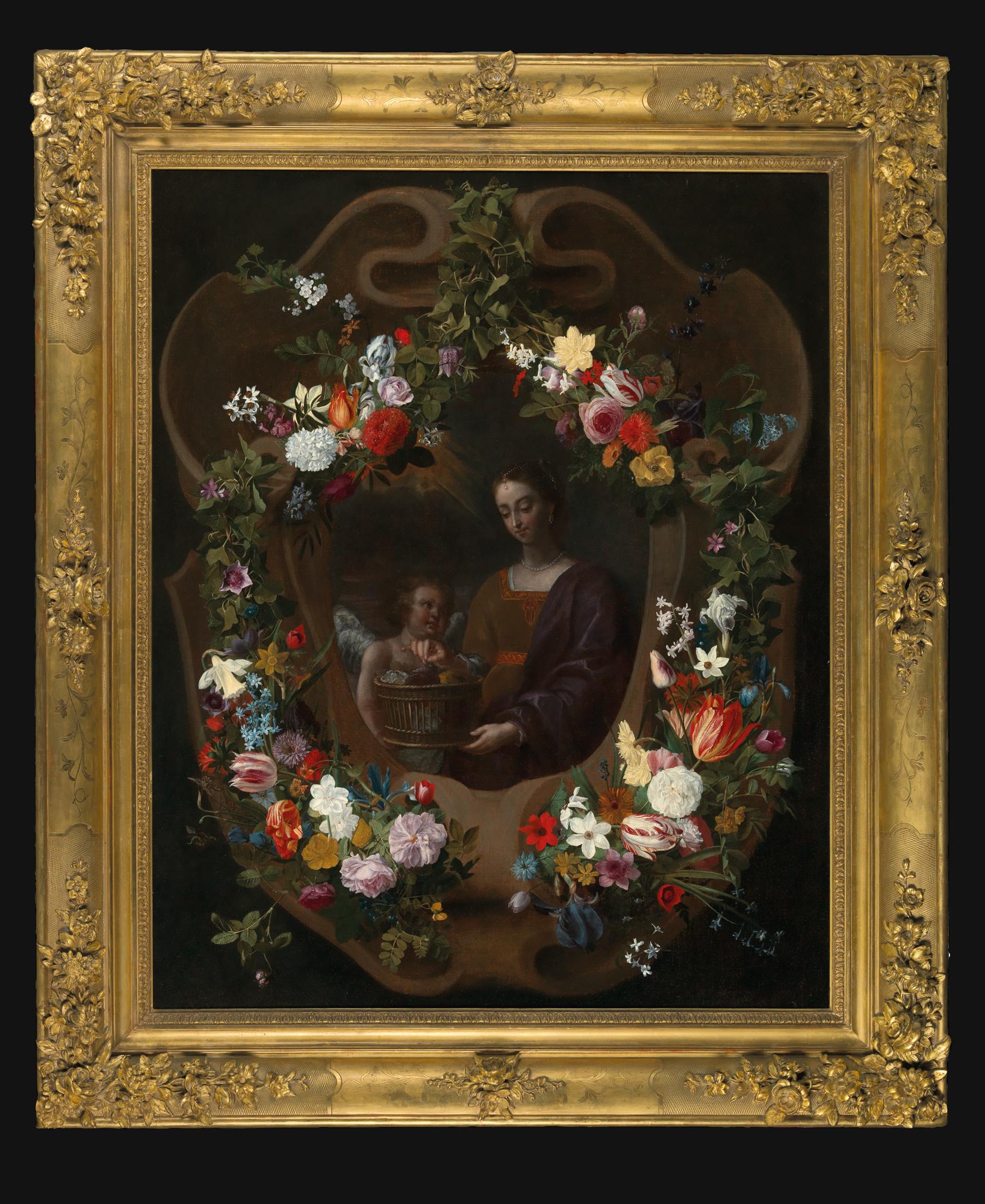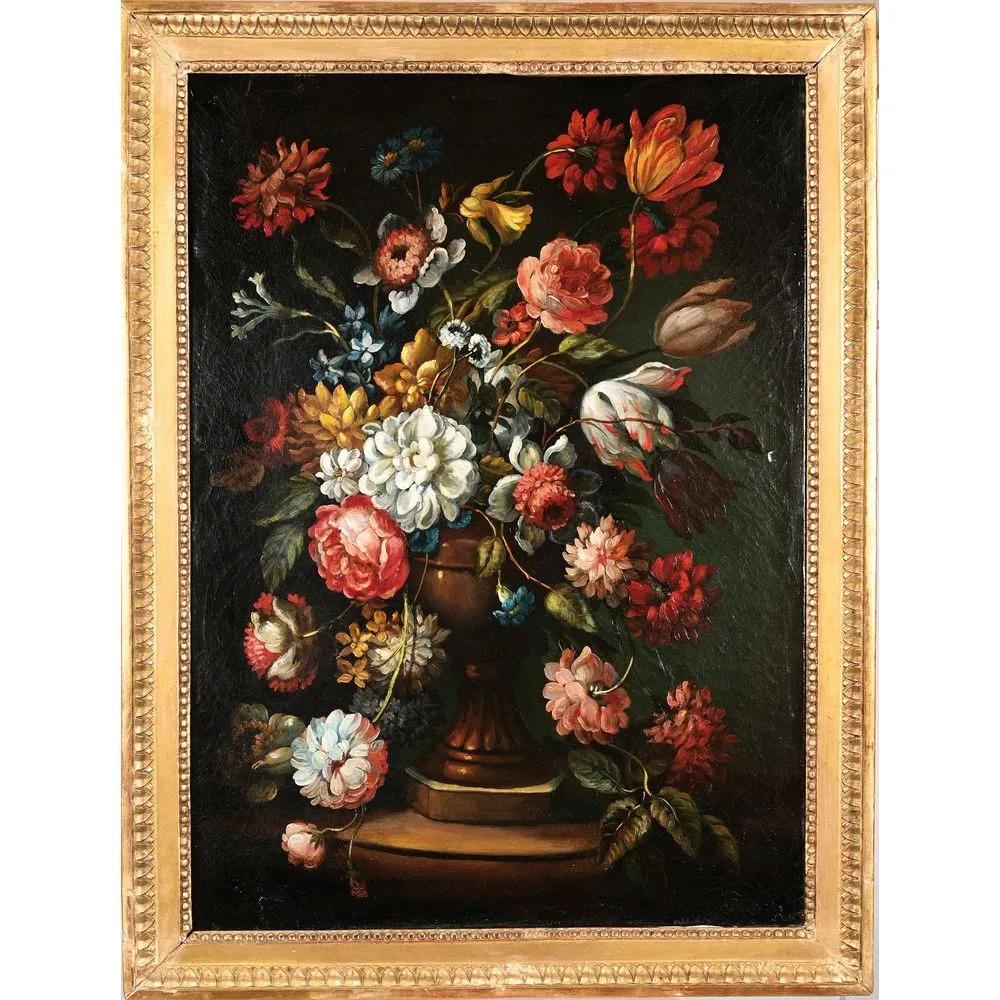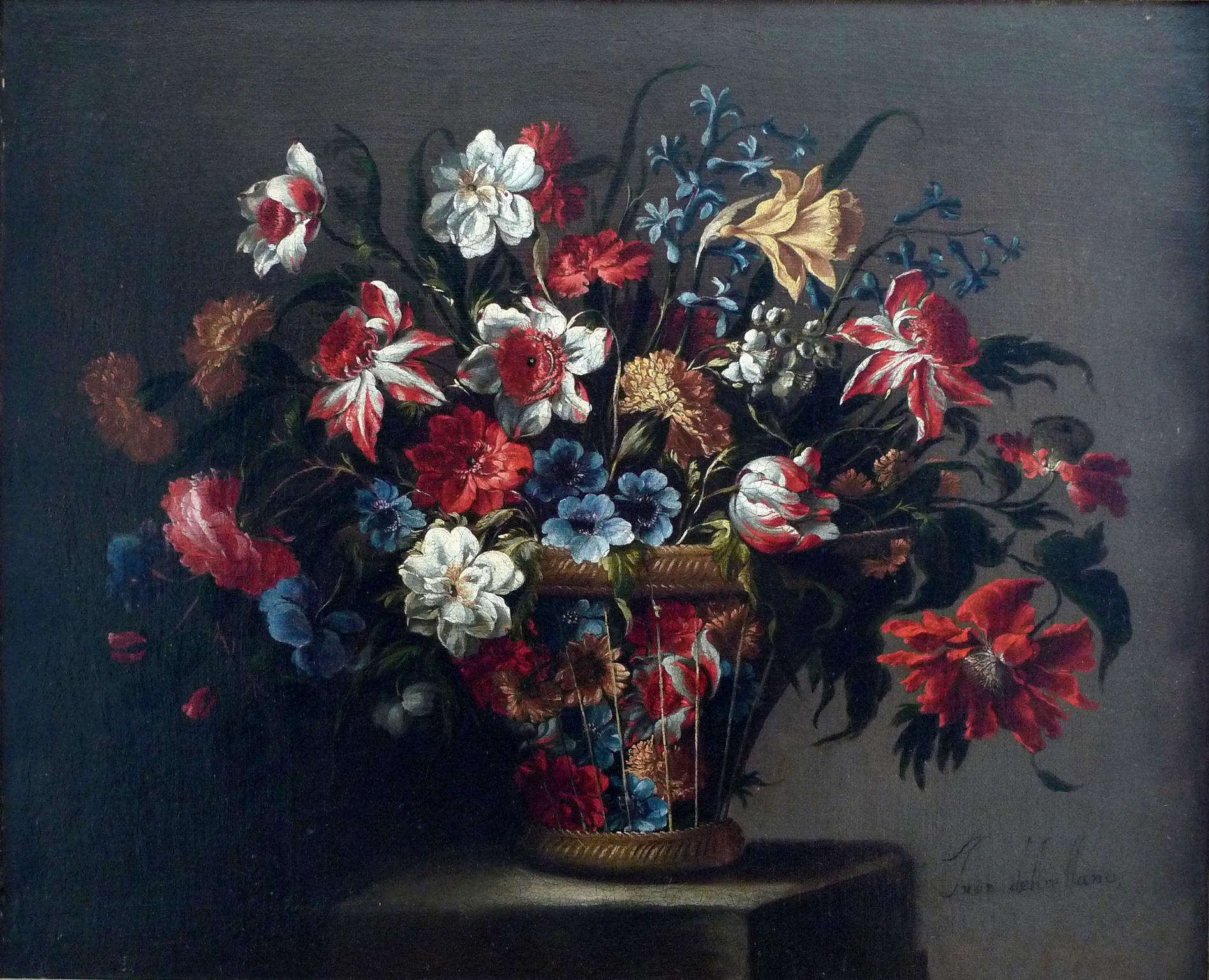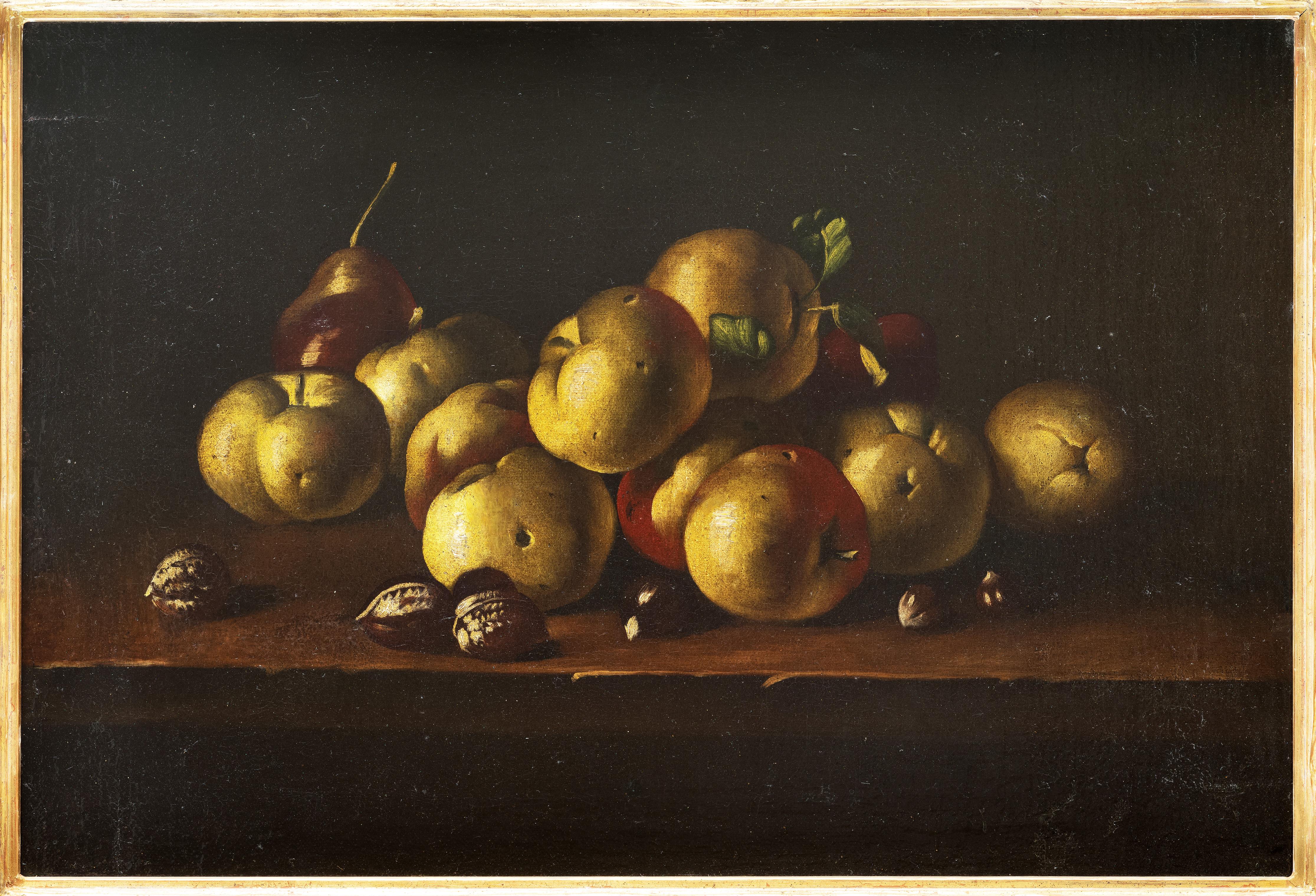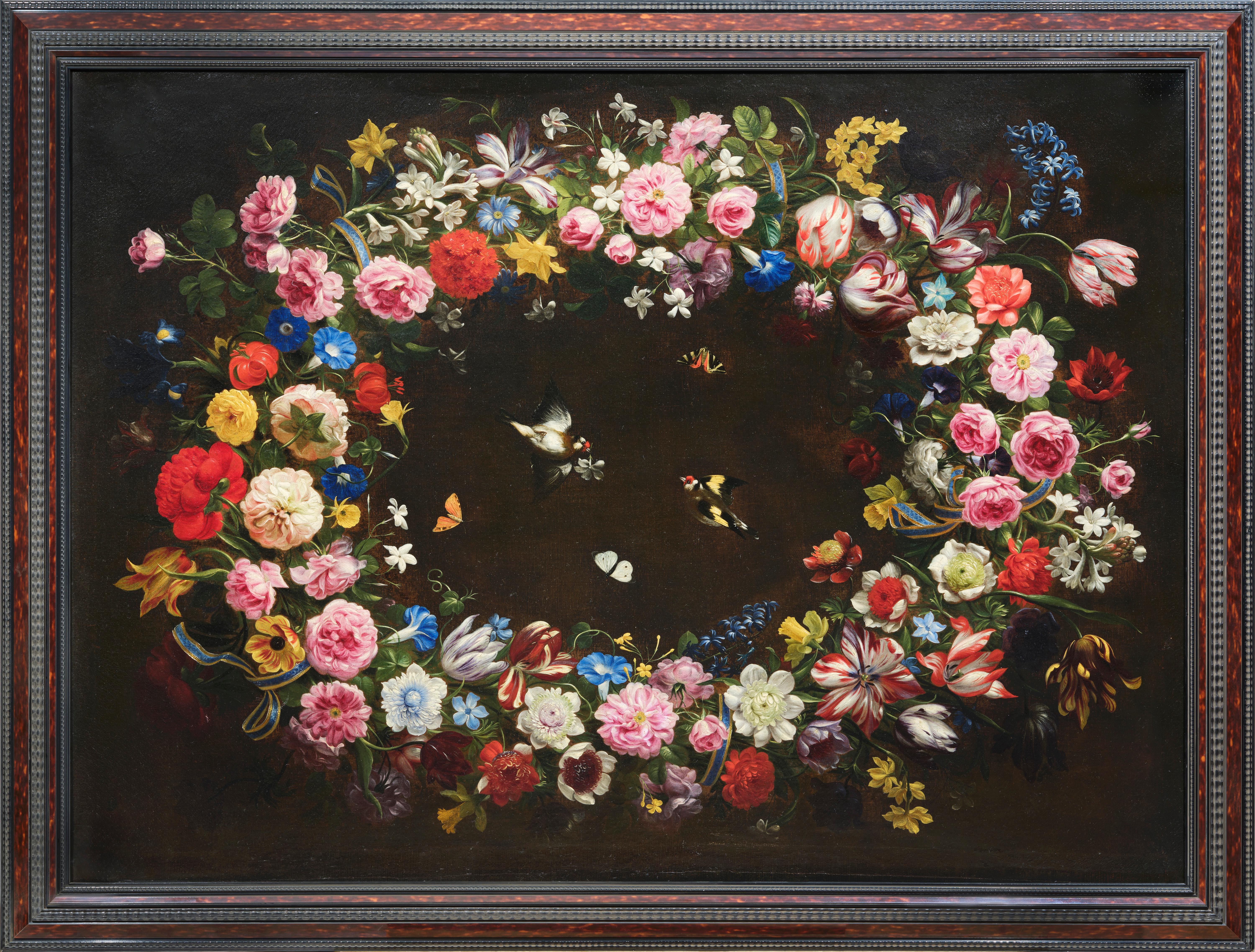Items Similar to FLOWERS -In the Manner of Mario Dei Fiori -Oil On Canvas Italian Painting
Want more images or videos?
Request additional images or videos from the seller
1 of 11
Maximilian CicconeFLOWERS -In the Manner of Mario Dei Fiori -Oil On Canvas Italian Painting2002
2002
About the Item
Flowers - Oil on canvas cm.80x60 by Maximilian Ciccone, Italy 2002.
Frame available on request from our workshop.
In this oil on canvas painting the painter Ciccone draws inspiration from the masterpieces of the great Roman master Mario Nuzzi known as Mario dei Fiori.
The bouquet of flowers is presented in a decorated terracotta vase, all represented on a dark background on which the flower corollas stand out.
- Creator:Maximilian Ciccone (1972, Italian)
- Creation Year:2002
- Dimensions:Height: 31.5 in (80 cm)Width: 23.63 in (60 cm)
- Medium:
- Movement & Style:
- Period:
- Framing:Framing Options Available
- Condition:
- Gallery Location:Napoli, IT
- Reference Number:1stDibs: LU56836841082
About the Seller
4.8
Vetted Seller
These experienced sellers undergo a comprehensive evaluation by our team of in-house experts.
1stDibs seller since 2017
148 sales on 1stDibs
Typical response time: 1 to 2 days
- ShippingRetrieving quote...Ships From: Napoli, Italy
- Return PolicyA return for this item may be initiated within 14 days of delivery.
More From This SellerView All
- Still Life - Italian Oil On Canvas Painting by Antonio JannoneBy ANTONIO JANNONELocated in Napoli, ITStill life - Oil on canvas cm.100x150, Antonio Jannone, Italy, 2003. Frame available on request.Category
Early 2000s Old Masters Still-life Paintings
MaterialsCanvas, Oil
- STILL LIFE WITH FLOWER FRUIT AND BIRDS - Oil on canvas Italy Alfredo MayeuxLocated in Napoli, ITOil painting on canvas - Composition of flowers in a metal vase with fruit, and landscape in the background - Alfredo Mayeux; early XX century.Category
Mid-20th Century Old Masters Still-life Paintings
MaterialsOil, Canvas
- STILL LIFE - Massimo Reggiani - Oil on Canvas Italian PaintingBy Massimo ReggianiLocated in Napoli, ITSTILL LIFE - Oil on canvas cm. 40x50 by Massimo Reggiani, Italy 2005 Still life, a pictorial representation of foodstuffs, objects or inanimate objects, was one of the artistic genres that became completely independent in the seventeenth century. Reggiani has composed this still life inspired by the Dutch school. Fruit, grapes and peaches...Category
21st Century and Contemporary Old Masters Still-life Paintings
MaterialsCanvas, Oil
- STILL LIFE - Dutch School Baroque - Oil on Canvas Italian PaintingBy Salvatore MarinelliLocated in Napoli, ITStill life - Salvatore Marinelli Italia 2007 - Oil on canvas cm. 60x40 Salvatore Marinelli's painting is a beautiful reinterpretation by Pieter Claesz Dutch Baroque painter, one of the best known specialists in still life, having banquet scenes as its main theme. In Marinelli's painting the gold and silver colors emerge clearly on the dark background and on the gold velvet tablecloth...Category
Early 2000s Old Masters Still-life Paintings
MaterialsCanvas, Oil
- STILL LIFE - In the Manner of Adriaen Coorte - Oil on Canvas Italian PaintingBy Salvatore MarinelliLocated in Napoli, ITStill life - Salvatore Marinelli Italia 2007 - Oil on canvas cm. 50x100 Salvatore Marinelli's painting is a still life with black and white grapes, peaches, melon, a basket of pomegranates and figs. Objects and light are intensely studied and are painted with wonderful tenderness with variety of fruits. Marinelli is inspired by one of the many works by Adriaen Coorte...Category
Early 2000s Old Masters Still-life Paintings
MaterialsCanvas, Oil
- FLOWERS - Oil on Canvas Italian Still Life PaintingLocated in Napoli, ITFlowers - Oil on canvas cm.70x90, Luigi Degli Espositi, Italy, 2002 Gold leaf gilded wooden frame available on requestCategory
Early 2000s Old Masters Still-life Paintings
MaterialsCanvas, Oil
You May Also Like
- Grand-Scale Old Master Garland Portrait, 17th Century, Signed & Dated, Rare workLocated in London, GBIndistinctly signed and dated In the first quarter of the 17th century a new form of flower painting was developed in Flemish painting, which, recreated by a large group of artists and workshops, would achieve considerable success throughout the century in much of Europe: the garland of flowers surrounding a central figure. Brueghel de Velurs was the initiator of this type of composition, however, it was his pupil, Daniel Seghers, who was the dominant figure in this specialised production and the creator of a prototype that would serve as a model for the numerous artists who followed in his wake. It seems undeniable that the artist of the present painting had seen the Garlands of Flowers Surrounding a Medallion Depicting the Triumph of Love by Daniel Seghers and Domenico Zampieri (now in the Musée du Louvre in Paris). In our painting, the present floral wreath encircles a carved cartouche within which sits Saint Dorothy of Caesarea and the attribute which often accompanies her in art, a basket of roses. The extremely delicate flowers have been rendered in meticulous detail, so that every species can be identified from exotic tulips to roses, irises and forget-me-nots; this obvious attention to naturalism is inherited from the Flemish manner. Each flower is so precise and refined that they are an individual study in their own right. The still-lifes are from the hand of Jan Anton van den Baren, with the central figures by another accomplished hand. Van den Baren’s arrangement of flowers would have delighted connoisseurs in both Flanders and in Vienna, where the impossibility of their all blooming at the same time of year would have been understood as a further statement of the wonder and beauty of the divine. Van den Baren worked first in Brussels, where he collaborated with Erasmus Quellinus II for the figures in his works, before moving with Archduke Leopold Wilhelm, his patron, to Vienna in 1656, where he instead worked with fellow Flemish émigré painter Nikolaus van Hoy. The iconography relates to an eighth century legend where she was presented a basket of roses by a child. In addition to the brilliance of his handling of still-lifes Van den Baren played an important art historical role as Director of Archduke Leopold Wilhelm’s Picture Gallery in Vienna, then one of the greatest collections in the world and the core of what was to become the present collection of the Kunsthistorisches Museum, Vienna. Van der Baren compiled an inventory of the collection in 1659, and his predecessor as Director of the Archduke’s Picture Gallery (when it was still housed in Flanders), David Teniers, depicted van der Baren (third from right) in his celebrated Archduke Leopold Willem in his gallery at Brussels, conserved at the Kunsthistorisches Museum. It is a shining example of the Flemish Baroque and is a very rare object indeed, considering there are only 14 paintings accepted as authentic works by this artist. We are grateful to Fred Meijer for confirming the attribution to Johannes Antonius van der Baren. A feature of this painting is its outstanding carved and gilded frame with a plethora of flowers and foliage. Titan Fine ArtCategory
17th Century Old Masters Portrait Paintings
MaterialsCanvas, Oil
- École flamande du XVIIIe sLocated in ROUEN, FRSuiveur De Cornelis De Heem (1631-1695) Bouquet de fleurs dans un vase, huile sur toile. 69x56,5 cmCategory
18th Century Old Masters Still-life Paintings
MaterialsCanvas, Oil
- "Cesta de flores", 17th Century Oil on Canvas, Still Flowers by Juan de ArellanoBy Juan de ArellanoLocated in Madrid, ESJUAN DE ARELLANO Spanish, 1614 - 1676 Cesta de Flores signed Juan de Arellano (lower lright) oil on canvas original period carved, gilt and polychrome...Category
17th Century Old Masters Still-life Paintings
MaterialsCanvas, Oil
- A gentleman’s vicesLocated in London, GBEnglish School, circa 1827 A gentleman’s vices the newspaper dated ‘Sunday December 23 1827’ (upper left) oil on canvas 20 ¾ x 24 ½ in. (52.7 x 62.3 cm.) frame 25 ⅝ x 29 ¼ in. (65.1...Category
Early 19th Century Old Masters Still-life Paintings
MaterialsCanvas, Oil
- Still Life with Apples and Nuts, 17th Century, Old Master, Spanish PaintingLocated in Greven, DEJuan Sánchez Cotán (1560 - 1627) was one of the most important still life painters in Spain and beyond. He developed a certain type of still life with a ...Category
17th Century Old Masters Still-life Paintings
MaterialsCanvas, Oil
- Flower Garland by Giovanni Stanchi, the most Flemish Italian flower painterBy Giovanni StanchiLocated in PARIS, FRThis painting is reproduced in the reference book on Roman still life "Pittori di nature morta a Roma - artisti italiani 1630 -1750" by Gianluca and Ulisse Bocchi - Arti Grafiche Castello 2005 (page 250 figure FS5), where it is mentioned as one of the few paintings that can be given with certainty to Giovanni Stanchi. This highly decorative flower garland reveals a very strong Flemish influence, enabling us to attribute it with certainty to Giovanni Stanchi, the eldest of a sibling group of painters active in the production of still lifes in 17th century Rome. Probably painted before 1640, our garland conceals a mystical message beneath its decorative opulence, which we're about to reveal ... 1. Giovanni, Niccolò and Angelo Stanchi, a brotherhood of still-life painters in 17th-century Baroque Rome The three Stanchi brothers, Giovanni (1608 - after 1675), Niccolò (ca. 1623 - 1690) and Angelo (1626 - after 1675) lived and worked together (like the Le Nain brothers), making identification of the different hands perilous. Giovanni Stanchi's name is first mentioned in 1634, in the register of the painters' guild of the "Accademia di San Luca". Paid membership of the painters' guild provided not only a social network, but also commissions from important Roman families. In 1638, Giovanni Stanchi painted a picture for the Barberini family depicting their coat of arms surrounded by flowers. In 1660, he was commissioned by Cardinal Flavio Chigi to decorate a gallery with still lifes of flowers and fruit. The Chigis remained his principal patrons until after 1673. Thereafter, he received commissions from almost every important family in Rome. An invoice dated 1670 identifies Giovanni Stanchi and Mario Nuzzi as the painters responsible for the still lifes that decorated the famous mirrors in Palazzo Colonna. In 1675, Giovanni Stanchi's name appears for the last time in connection with a project in which he was engaged, together with Andries Bosman and the figure painter Ciro Ferri, to decorate the mirrors of the Palazzo Borghese on Campo Marzio. Although all three brothers were active as painters, the records of their commissions always refer to Giovanni, since, as eldest brother, he was responsible for invoices and contracts. Only in a few cases is the name of one of the younger brothers mentioned. Only paintings with a strong Flemish influence dating from the first four decades of the 17th century, such as this one, can be attributed with certainty to Giovanni, as he was the only painter in the family at the time. 2. History of a genre: the flower garland Jan Brueghel the Elder (Brussels 1568 - Antwerp 1625) is credited with inventing the flower garland theme during his stay in Rome in 1592. Such garlands were originally used to surround a religious subject, often a Marian one. This religious scene could sometimes be painted by another artist, as in the painting acquired in 1608 by Cardinal Borromeo, featuring a Madonna (painted by Henry van Balen), surrounded by a garland painted by Jan Brueghel. This theme was taken up and developed in Rome from 1625 onwards by Daniel Seghers, before the young Giovanni Stanchi made it his own, reinforcing its symbolic dimension (to which we shall return) and moving away from the naturalistic approach of Jan Brueghel to develop a certain idealization of each flower, closer to the style of Mario Nuzzi (Rome 1603 - 1673). Giovanni Stanchi's garlands, of which he was the best Italian interpreter in the 17th century, also reveal him to be one of the most faithful to the Flemish tradition. The book by Gianluca and Ulisse Bocchi lists nine still lifes very similar to ours, all executed on a black background (including the one reproduced as the last photo in the gallery, which belongs to the Pinacoteca Nazionale in Bologna). Because of their proximity to Flemish works, they can be attributed with certainty to Giovanni Stanchi. Four of them belong to private collections, while the others are all in public institutions (Anhaltische Gemäldegalerie, Dessau; Galeria del Palazzo Bianco, Genoa; Musée des Beaux-Arts, Bordeaux; Pinacoteca Nazionale, Bologna; Palazzo Chigi-Saraceni, Siena). Like those in Flemish still lifes, the flowers depicted by Giovanni Stanchi bloom at different times of the year, ruling out any representation of a real bouquet. Alongside the more traditional flowers of our gardens (roses, tulips, hyacinths, daffodils, irises), it is also interesting to note the frequent inclusion of more exotic flowers such as jasmine and blue bindweed (ipomoea indica), which had been recently introduced to Europe from Mexico. Each flower painted by Giovanni Stanchi seems to have its own individuality, a trait characteristic of Flemish painting, of which Stanchi was the best interpreter in Italy. One could say that Stanchi does not depict garlands of flowers, but flowers in a garland, each with its own identity and specificity, making it unique and different from the others. Captured in a low-angled light that seems to have captured them for eternity, they are drawn with clear, precise lines. As if they had been freshly cut, they emerge from the darkness in geometric figures that reinforce the tactile quality of their representation. One of Giovanni Stanchi's distinctive features is to have substituted the central religious representation traditionally associated with Flemish flower...Category
17th Century Old Masters Still-life Paintings
MaterialsCanvas, Oil
Recently Viewed
View AllMore Ways To Browse
Roman Terracotta Vase
Semper Augustus
Sir Herbert Hughes Stanton
Steve Capper Artist
Thailand Travel Poster
The Perfect Martini Painting
Tim Snowdon
Una Lekuze
Zhou Brothers
1930 Cadillac Wheels
24 K Gold Cross
Antique Mason Jars
Blue Baby Bottle Used
Blue Mason Jars
Cafetiere Vintage
Chinese Revolutionary Army
Chrysanthemum Yellow And Orange
Claude Benard On Sale
